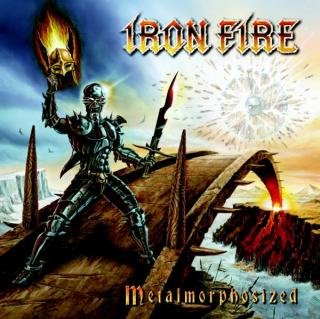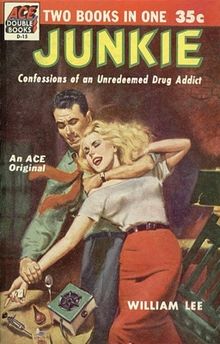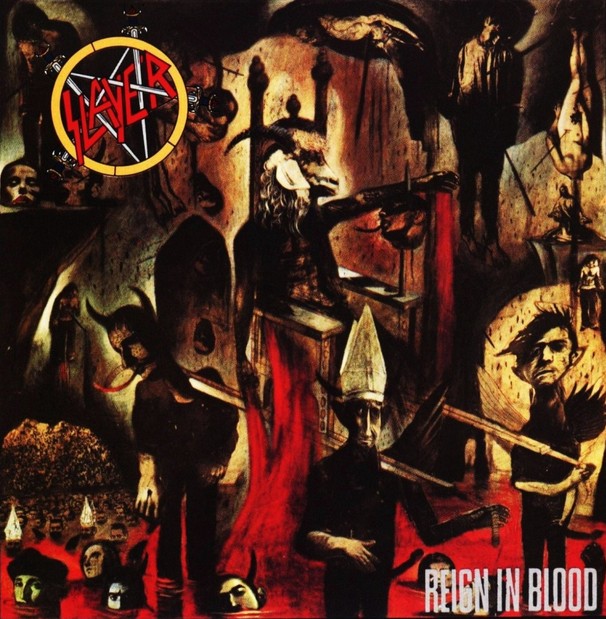 What do you do when you have some new songs, but not enough for an album? When you’ve got unreleased tracks, but not enough for a compilation? When you’ve got a bunch of band members hanging around the studio, but they’re not seriously interested in a reunion? In 2010, Danish power metal band Iron Fire’s answer was to “do all three simultaneously.”
What do you do when you have some new songs, but not enough for an album? When you’ve got unreleased tracks, but not enough for a compilation? When you’ve got a bunch of band members hanging around the studio, but they’re not seriously interested in a reunion? In 2010, Danish power metal band Iron Fire’s answer was to “do all three simultaneously.”
It’s hard to figure out exactly what sort of album this is – most database type websites consider it a new studio release, but most of it was written in 2003, and was present in rough form in various demos. It’s mixed up with a few, and all of them are recorded by the band’s former members: and it’s a metal band, so there’s a ton of former members.
I don’t know why they bothered tracking down every random asshole who was ever in this band to contribute instruments – you can’t hear any difference. The drums are very triggered and mechanical. The guitars are a pulverising backwash of distortion. You’re not going to be smiling and thinking “hey, that’s Morten Plenge on drums!” Everyone’s performance sounds fairly interchangeable, except for vocalist Martin Steene, who has always humanised some very inhuman music and continues to do so here.
The songs are all fairly strong, although it’s clear why some of them never appeared on a real Iron Fire album. “The Phantom Symphony” is long-winded, but contains a lot of tasty treats, tacky horror-movie obsessed lyrics aside. “Back to the Pit” and “The Graveyard” are just the usual fare. “Crossroads” is a ballad that serves to break up the relentless speed that dominates most of the album.
The new songs are better. “Reborn to Darkness” has a jangly, progressive edge to its riff approach. “Still Alive” lays on the quadtracked guitars, sounding more like Nevermore than a European power metal band. “My Awakening” is fast and powerful as fuck, probably the most immediate and memorable track on the album, with some well-placed death metal vocals in the chorus. The bonus version of the album contains an orchestral version of “Crossroads” and another re-recorded song called “Afterlife”, which sounds pleasant enough.
The presentation and production is good, but it’s not as much as a retrospective as you’d hope for – this is a VERY modern sounding Iron Fire. I hope you like downtuned guitars and death metal vocals. Ultimately I don’t know how necessary something like this is – Metalmorphosized is something aimed at the band’s hardcore fans, and they’d probably be more satisfied by hunting down the demos that these songs originally appeared on. Still one of the more memorable compilation-cum-studio-cum-reunion albums I’ve heard.
 Before Burroughs decided his purpose in life was to beat the English language like a bitch who owed him money, he was writing things like this – a sane, lucid, and readable pulp novel about his addiction to heroin. Books about drugs often have a hallucinogenic quality, as if they’re trying to give the reader a second hand high. This isn’t like that. Burroughs is offering his body as a testing ground: he puts substances into it and writes about it in analytic terms.
Before Burroughs decided his purpose in life was to beat the English language like a bitch who owed him money, he was writing things like this – a sane, lucid, and readable pulp novel about his addiction to heroin. Books about drugs often have a hallucinogenic quality, as if they’re trying to give the reader a second hand high. This isn’t like that. Burroughs is offering his body as a testing ground: he puts substances into it and writes about it in analytic terms.
This was shocking in 1953. In 2015, not so much. Rich trust fund brat pulls the silver spoon from his mouth and starts cooking coke on it: stop the presses. Even if it’s not a pack of lies like A Million Little Pieces, the story is very familiar. I feel like I’m reading about a man’s disclosure of sexual envy and mid-life ennui. We get it. This is not special.
Its interesting if you want to know more about drug culture in America before Vietnam, Iran-Contra, crack cocaine, and all the rest. But really, not that much happens in it. Burroughs describes how he got involved with the scene, the interesting characters he met, and his occasional run-ins with the law. Beyond that, he doesn’t tell us much. This isn’t an exploration of man’s dark heart, it’s a police report.
Subsequent re-issues have tried to shoot steroids into the story with lurid, impressionistic cover art. But the original Ace Books cover art best captures the spirit of the tale: a man struggling with a woman, who has knocked a hypodermic syringe out of his hand. This is the most dramatic incident in the book, and even then it’s not all that interesting. Burroughs’ sexual proclivities are written about in the same dry way – he throws in off-handed mentions about boffing men, and then its back to scoring drugs. I was curious for more. These details about his life could have been expanded upon, and expounded upon. Instead, we get sketches.
But Junky has some moments where Burroughs really hits paydirt and gives us something good. I liked his description of being a drug addict. Paraphrased, it goes something like “I didn’t take drugs to get high. I took drugs to be functional. Heroin meant I could brush my teeth and shave myself and put on clean clothes. That was my high.” Pleasure operates at a tight Malthusian limit: no matter how much you dump into the brain, once a habit starts there will never be enough. I was reminded of a rotten.com article on crystal meth, and how quickly you degrade to a state where basic, mundane life is impossible without it.
Moments like that are chinks in the armor of Junky, and I wish there were more. Right now, it seems like a paradox – a tell-all book that tells almost nothing. I was hoping for more insights, more details, more specifics on what it’s like to be a man like Burroughs in the 1950s. I wonder if the good stuff was left on the cutting room floor: this was a different age for publishing, just as it was for everything else.
I suppose you could argue that Burroughs promotes a positive social message by making drugs look boring.
 Reign in Blood has some great tracks – and not just the two everyone remembers, either.
Reign in Blood has some great tracks – and not just the two everyone remembers, either.
“Epidemic,” for example, has an addictive syncopated gallop riff that’s worth tuning down to Eb so you can play along. “Postmortem” is punchy and powerful, and perfectly leads into “Raining Blood” (the two will be forever linked in the fans’ minds, due to a mastering error that put the first verse of “Raining Blood” at the end of “Postmortem”).
But much of it is an unfocused riff salad, full of tracks that don’t come off as songs but 2-3 minute explosions of energy. “Epidemic” is riff, verse, riff, verse, verse, break, riff, verse, fin! “Criminally Insane” is another half a song that speeds up and slows down in a spontaneous, unplanned way – there’s not really a musical thru-line of tension and release. It’s like it was written by a Turing-incompatible computer.
“Necrophobic” is super fast, but sounds more like four guys trying to set a land speed record than music.
The album’s greatest moment is “Angel of Death”, which has great riffs, a crushing middle break, and lyrics about Nazis. I refuse to believe this was not a marketing strategy. When you’re a female pop duo (think tATu or The Veronicas), you’ve got to have people thinking you’re lipstick lesbians. When you’re a metal band, you’ve got to have people thinking you’re Nazis or Satanists. It worked for KISS and Black Sabbath, so why not Slayer?
The album’s so heavy, fast, and evil that it’s almost overpowering…but I wish it was more consistent. Great riffs share flat space with dull “speed-pick one note until you die of boredom” time fillers. Heavy metal classics rub shoulders with tracks that don’t even sound finished. It’s very uneven moment to moment and minute to minute. Even the vaunted lyrics frequently dissolve turn into shouted tirades about Satan and slashings.
I like Dave Lombardo’s drumming. This is basically the benchmark for metal drumming in 1986. Nobody else was playing this fast or this technically – except perhaps for Dark Angel’s Gene Hoglan. The production is also quite good – sharp and clinical, with clear and crisp allocation of sonic space between the kicks, the rhythm guitars, the what-have-you. The whole affair clocks in at under 30 minutes – say what you will about it, but it does not overstay its welcome.
 What do you do when you have some new songs, but not enough for an album? When you’ve got unreleased tracks, but not enough for a compilation? When you’ve got a bunch of band members hanging around the studio, but they’re not seriously interested in a reunion? In 2010, Danish power metal band Iron Fire’s answer was to “do all three simultaneously.”
What do you do when you have some new songs, but not enough for an album? When you’ve got unreleased tracks, but not enough for a compilation? When you’ve got a bunch of band members hanging around the studio, but they’re not seriously interested in a reunion? In 2010, Danish power metal band Iron Fire’s answer was to “do all three simultaneously.”

